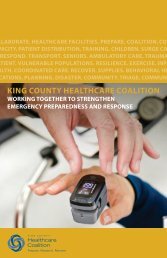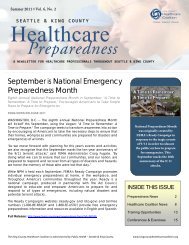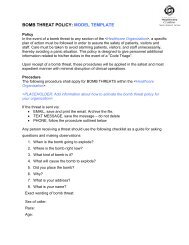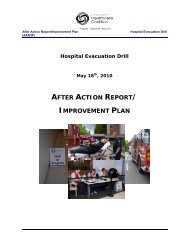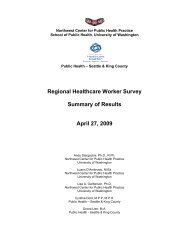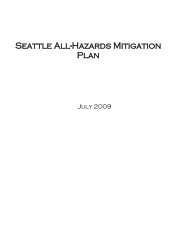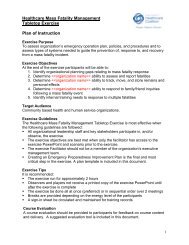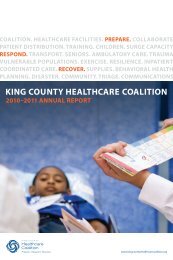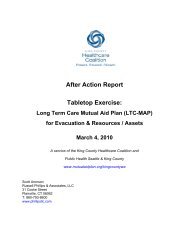NIMS COMPLIANCE TRACKING TEMPLATE In September 2006 ...
NIMS COMPLIANCE TRACKING TEMPLATE In September 2006 ...
NIMS COMPLIANCE TRACKING TEMPLATE In September 2006 ...
You also want an ePaper? Increase the reach of your titles
YUMPU automatically turns print PDFs into web optimized ePapers that Google loves.
<strong>NIMS</strong> <strong>COMPLIANCE</strong> <strong>TRACKING</strong> <strong>TEMPLATE</strong><br />
<strong>In</strong> <strong>September</strong> <strong>2006</strong>, the National <strong>In</strong>cident Management System (<strong>NIMS</strong>) <strong>In</strong>tegration<br />
Center, along with the Department of Health and Human Services, outlined 17 elements<br />
of compliance as implementation activities for Hospitals and Healthcare. Four of the<br />
seventeen elements were required to be eligible for Federal Preparedness Grant<br />
Funding in FY2007. The following document was originally created to provide a<br />
template for healthcare organizations to track <strong>NIMS</strong> Implementation activities internally.<br />
It has now been modified to assist healthcare organizations in tracking compliance<br />
activities.<br />
<strong>In</strong> May 2008, <strong>NIMS</strong> Implementation Activities for Healthcare and Hospitals were<br />
updated and 14 of the original 17 elements were identified as most applicable to<br />
healthcare organizations for compliance objectives in FY2008. Hospitals and healthcare<br />
organizations were expected to complete all 14 elements by <strong>September</strong> 30, 2009.<br />
Activities from previous years to the 2008/2009 requirements are compared in the<br />
Crosswalk of the 2007 & 2008/2009 <strong>NIMS</strong> Healthcare Activities/Objectives, dated<br />
11/2008, available on the <strong>NIMS</strong> <strong>In</strong>tegration Center website.<br />
The following template outlines each of the activities required for compliance to meet<br />
the 14 elements for healthcare. It begins with a directive acknowledging that the<br />
organization has adopted <strong>NIMS</strong> and continues with sections that outline the 14<br />
compliance activities. Examples of activities within each section are provided to assist<br />
with filling out the template and are highlighted in yellow. The template provides a<br />
mechanism for the <strong>NIMS</strong> requirements to be tracked internally to validate compliance.<br />
As <strong>NIMS</strong> compliance activities expand, the template will be updated. Please contact<br />
Danica Mann at Danica.mann@overlakehospital.org with any questions about <strong>NIMS</strong><br />
implementation activities.<br />
DRAFT <strong>TEMPLATE</strong> - Last Updated June 2009 1
<strong>NIMS</strong> IMPLEMENTATION DIRECTIVE<br />
<strong>In</strong> February 2003, in Homeland Security Directive-5, the President directed the<br />
Secretary of the Department of Homeland Security to develop and administer a National<br />
<strong>In</strong>cident Management System (<strong>NIMS</strong>). The goal of <strong>NIMS</strong> is to provide a consistent<br />
nationwide approach for federal, state, local, and tribal governments to work together<br />
more effectively and efficiently to prevent, prepare for, respond to, and recover from<br />
disasters, regardless of cause, size, or complexity. Ultimately, the implementation of the<br />
activities required by the <strong>NIMS</strong> are designed to strengthen the relationship between<br />
hospitals, local public health and other emergency response agencies.<br />
, in cooperation with Public Health Seattle and King County, the<br />
King County Healthcare Coalition, local emergency management and other response<br />
partners, will develop a program to integrate the National <strong>In</strong>cident Management System,<br />
to the extent appropriate, into our emergency management program. National <strong>In</strong>cident<br />
Management System compliance activities, as outlined in the <strong>NIMS</strong> Alert 202-646-3850,<br />
“<strong>NIMS</strong> Implementation Activities for Hospitals and Healthcare”, will be addressed in the<br />
. The hospital emergency manager will<br />
identify any statutes or regulations that need to be modified to facilitate implementation<br />
of the <strong>NIMS</strong> and will track implementation annually as part of the emergency<br />
management program.<br />
will report on the status of <strong>NIMS</strong> compliance activities as<br />
directed by the Washington State Department of Health.<br />
Implementation activities will proceed as outlined in the following <strong>NIMS</strong> Implementation<br />
Strategy.<br />
__________________________________ ______________________<br />
(Name of Signing Authority)<br />
(Date)<br />
<br />
DRAFT <strong>TEMPLATE</strong> - Last Updated June 2009 2
<strong>NIMS</strong> IMPLEMENTATION STRATEGY<br />
I. Purpose<br />
This document establishes that is compliant with the elements<br />
of <strong>NIMS</strong> outlined for healthcare to ensure compliance with HSPD-5, Management of<br />
Domestic <strong>In</strong>cidents. HSPD-5 requires all Federal Departments and agencies to adopt<br />
the <strong>NIMS</strong> and requires all state and local jurisdictions to implement the <strong>NIMS</strong> to receive<br />
federal preparedness funding. This plan illustrates that the required elements of <strong>NIMS</strong><br />
for healthcare are met and maintained by plans and training<br />
programs.<br />
II.<br />
Responsibilities<br />
a. <br />
Position Title<br />
Point of<br />
Contact<br />
Office<br />
Telephone<br />
Responsibilities to Ensure<br />
Full Adoption of the <strong>NIMS</strong><br />
III.<br />
<strong>NIMS</strong> Implementation Objectives<br />
<strong>NIMS</strong> requirements are outlined in 5 sections throughout this document. These<br />
sections are outlined in the <strong>NIMS</strong> Implementation Objectives for Healthcare<br />
Organizations dated 6/08. The first section addresses <strong>NIMS</strong> Adoption, which will include<br />
a list of which departments / business units are appropriate to include in the <strong>NIMS</strong><br />
activities (i.e. laboratory, emergency department, security, etc). The second section<br />
addresses planning, which covers emergency operations plans (EOPs), standard<br />
operating procedures (SOPs) as well as mutual aid agreements (MAAs). Section 3<br />
outlines training and exercises. It will cover who is responsible for the completion of<br />
which courses, listed by job title, as well as verify that <strong>NIMS</strong> principles are demonstrated<br />
in exercises.<br />
Section 4 addresses communications and information management. Common<br />
terminology, interoperable communications equipment, and information management<br />
are covered in this section. The last section outlines all the command and management<br />
activities, such as managing incidents using ICS (or HICS), applying an <strong>In</strong>cident Action<br />
Plan (IAP), and adopting Public <strong>In</strong>formation strategies consistent with partners in a<br />
response.<br />
DRAFT <strong>TEMPLATE</strong> - Last Updated June 2009 3
Section 1 Adoption<br />
1. Adopt <strong>NIMS</strong> throughout the healthcare organization including all appropriate<br />
departments and business units Preparedness Exercises - <strong>In</strong>corporate <strong>NIMS</strong>/ICS into<br />
all training and exercises<br />
2. Ensure Federal Preparedness awards support <strong>NIMS</strong> Implementation (in accordance<br />
with the eligibility and allowable uses of the awards)<br />
Section 2 Planning<br />
3. Revise and update emergency operations plans (EOPs), standard operating<br />
procedures (SOPs), and standard operating guidelines (SOGs) to incorporate <strong>NIMS</strong><br />
and National Response Framework (NRF) components, principles and policies, to<br />
include planning, training, response, exercises, equipment, evaluation, and corrective<br />
actions. Emergency response plans, including those that fulfill Emergency Support<br />
Functions under the NRP and internal response plans, such as COOP Plans and<br />
EOPs, must be modified to adopt <strong>NIMS</strong> principles and language.<br />
4. Participate in interagency mutual aid and/or assistance agreements, to include<br />
agreements with public and private sector and nongovernmental organizations.<br />
Section 3 Training and Exercise<br />
5. Identify the appropriate personnel to complete ICS 100, ICS 200 and IS 700, or<br />
equivalent courses.<br />
6. Identify the appropriate personnel to complete IS 800 or an equivalent course.ICS 100<br />
– <strong>In</strong>troduction to <strong>In</strong>cident Command System<br />
7. Promote <strong>NIMS</strong> concepts and principles into all organization-related training and<br />
exercises. Demonstrate the use of <strong>NIMS</strong> principles and ICS Management structure in<br />
training and exercises.<br />
Section 4 Communications and <strong>In</strong>formation Management<br />
8. Promote and ensure that equipment, communication, and data interoperability are<br />
incorporated into the healthcare organization’s acquisition program.<br />
9. Apply common and consistent terminology as promoted in <strong>NIMS</strong>, including the<br />
establishment of plain language communications standards.<br />
10. Utilize systems, tools, and processes that facilitate the collection and distribution of<br />
consistent and accurate information during an incident or event.<br />
Section 5 Command and Management<br />
11. Manage all emergency incidents, exercises, and preplanned (recurring/special) events<br />
in accordance with ICS organizational structures, doctrine, and procedures, as defined<br />
in <strong>NIMS</strong>.Resource Management – Maintain an inventory of organizational response<br />
assets<br />
12. ICS implementation must include the consistent application of <strong>In</strong>cident Action<br />
Planning (IAP) and common communications plans, as appropriate.Corrective Actions<br />
– <strong>In</strong>corporate corrective actions into preparedness and response plans and<br />
procedures<br />
13. Adopt the principle of Public <strong>In</strong>formation, facilitated by the use of the Joint <strong>In</strong>formation<br />
System (JIS) and Joint <strong>In</strong>formation Center (JIC) during an incident or event.<br />
14. Ensure that Public <strong>In</strong>formation procedures and processes gather, verify, coordinate,<br />
and disseminate information during an incident or event.<br />
DRAFT <strong>TEMPLATE</strong> - Last Updated June 2009 4
IV.<br />
<strong>NIMS</strong> Compliance Activities<br />
Section 1 - Adoption<br />
<strong>NIMS</strong> Compliance Activity Completed Notes Examples<br />
Adopt <strong>NIMS</strong> throughout the healthcare<br />
organization including all appropriate<br />
departments and business units<br />
Ensure Federal Preparedness awards<br />
support <strong>NIMS</strong> Implementation (in<br />
accordance with the eligibility and<br />
allowable uses of the awards)<br />
The directive at the<br />
beginning of this<br />
document assists<br />
with documenting this<br />
activity<br />
Utilizing ASPR<br />
training and exercise<br />
funding for ICS<br />
training and<br />
participation in<br />
exercises achieves<br />
this requirement<br />
Section 2 - Planning<br />
<strong>NIMS</strong> Compliance Activity Completed Notes Examples<br />
Revise and update emergency<br />
operations plans (EOPs), standard<br />
operating procedures (SOPs), and<br />
standard operating guidelines (SOGs) to<br />
incorporate <strong>NIMS</strong> and National<br />
Response Framework (NRF)<br />
components, principles and policies, to<br />
include planning, training, response,<br />
exercises, equipment, evaluation, and<br />
corrective actions.<br />
Participate in interagency mutual aid<br />
and/or assistance agreements, to include<br />
agreements with public and private<br />
sector and nongovernmental<br />
organizations.<br />
Plans, procedures,<br />
guidelines associated<br />
with this activity are<br />
listed in a table<br />
below.<br />
Mutual Aid<br />
agreements<br />
associated with this<br />
activity are outlined in<br />
a table below<br />
Plan, Procedure,<br />
or Policy<br />
Example: Emergency Operations<br />
Plan (EOP)<br />
Strategy for <strong>NIMS</strong><br />
Implementation<br />
Update to include <strong>In</strong>cident<br />
Command language, training plans<br />
and exercise requirements are<br />
defined by <strong>NIMS</strong> <strong>In</strong>tegration Center<br />
Adoption Date<br />
<strong>September</strong> 30, 2007<br />
DRAFT <strong>TEMPLATE</strong> - Last Updated June 2009 5
Mutual Aid<br />
Agreement<br />
Capacity<br />
Addressed<br />
<strong>In</strong>ternal Point of<br />
Contact<br />
Contact <strong>In</strong>formation<br />
Example: Linen<br />
Agreement<br />
Linens<br />
Section 3 – Training and Exercises<br />
<strong>NIMS</strong> Compliance Activity<br />
Identify the appropriate personnel to<br />
complete ICS 100, ICS 200 and IS 700,<br />
or equivalent courses.<br />
Identify the appropriate personnel to<br />
complete IS 800 or an equivalent course.<br />
Promote <strong>NIMS</strong> concepts and principles<br />
into all organization-related training and<br />
exercises. Demonstrate the use of <strong>NIMS</strong><br />
principles and ICS Management<br />
structure in training and exercises.<br />
Completed Notes Examples<br />
Training<br />
requirements are<br />
outlined in the table<br />
below<br />
All regional training<br />
and exercises, and<br />
templates provided<br />
by the King County<br />
Healthcare Coalition<br />
assist in achieving<br />
this requirement.<br />
Training Course Required Staff Completion Date<br />
Example: IS-700 National <strong>In</strong>cident<br />
Management System<br />
All EOC Staff <strong>September</strong> 30, 2007<br />
DRAFT <strong>TEMPLATE</strong> - Last Updated June 2009 6
Section 4 – Communications and <strong>In</strong>formation Management<br />
<strong>NIMS</strong> Compliance Activity<br />
Promote and ensure that equipment,<br />
communication, and data interoperability<br />
are incorporated into the healthcare<br />
organization’s acquisition program.<br />
Apply common and consistent<br />
terminology as promoted in <strong>NIMS</strong>,<br />
including the establishment of plain<br />
language communications standards.<br />
Utilize systems, tools, and processes<br />
that facilitate the collection and<br />
distribution of consistent and accurate<br />
information during an incident or event.<br />
Completed Notes Examples<br />
WSHA ensures this<br />
process is followed<br />
with all ASPR<br />
equipment purchases<br />
Adoption of the new<br />
proposed hospital<br />
codes is one<br />
example of applying<br />
common terminology<br />
in a healthcare<br />
setting.<br />
Connecting with<br />
Health and Medical<br />
Area Command by<br />
email, phone, or<br />
WATrac is one way<br />
to facilitate this<br />
requirement.<br />
Section 5 – Command and Management<br />
<strong>NIMS</strong> Compliance Activity<br />
Manage all emergency incidents,<br />
exercises, and preplanned<br />
(recurring/special) events in accordance<br />
with ICS organizational structures,<br />
doctrine, and procedures, as defined in<br />
<strong>NIMS</strong>.<br />
ICS implementation must include the<br />
consistent application of <strong>In</strong>cident Action<br />
Planning (IAP) and common<br />
communications plans, as appropriate.<br />
Adopt the principle of Public <strong>In</strong>formation,<br />
facilitated by the use of the Joint<br />
<strong>In</strong>formation System (JIS) and Joint<br />
<strong>In</strong>formation Center (JIC) during an<br />
incident or event.<br />
Ensure that Public <strong>In</strong>formation<br />
procedures and processes gather, verify,<br />
coordinate, and disseminate information<br />
during an incident or event.<br />
Completed Notes Examples<br />
Ensure your<br />
organization is<br />
following ICS by<br />
outlining it in<br />
response procedures<br />
and training staff<br />
regularly<br />
Complete an IAP for<br />
every exercise or real<br />
event that requires<br />
activation of your<br />
Healthcare<br />
Command Center<br />
Ensure your<br />
organization is<br />
connected with the<br />
Communications<br />
Team at PHSKC, as<br />
well as with local<br />
emergency<br />
management<br />
Outline these<br />
processes in your<br />
EOP and test them<br />
during exercises<br />
DRAFT <strong>TEMPLATE</strong> - Last Updated June 2009 7


